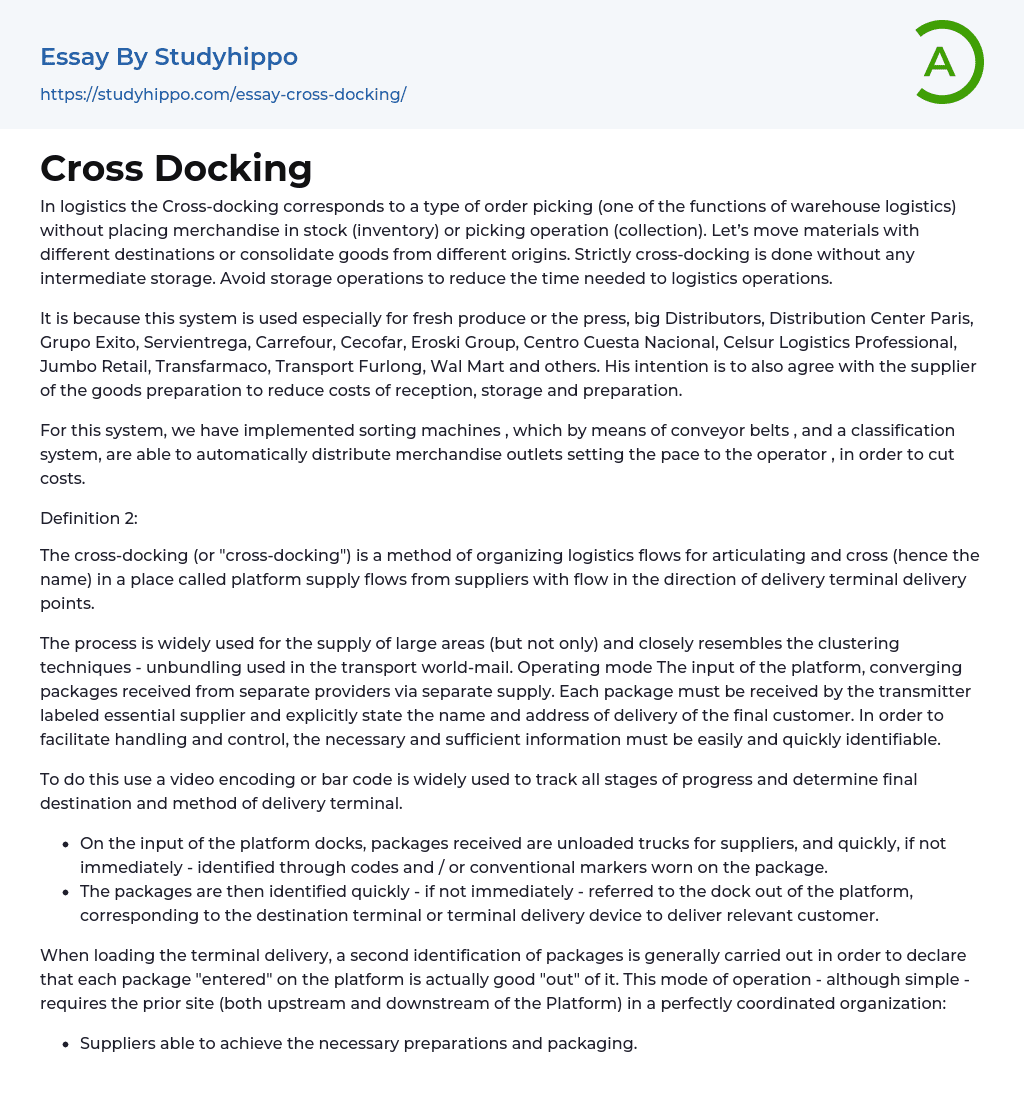Cross-docking in logistics is a type of order picking that does not include storing items or conducting picking operations. Instead, it involves transferring materials to different destinations or combining goods from various sources. This process eliminates the need for intermediate storage and aims to decrease the time needed for logistics operations.
This system is specifically used for fresh produce or the press, as well as big distributors like Distribution Center Paris, Grupo Exito, Servientrega, Carrefour, Cecofar, Eroski Group, Centro Cuesta Nacional, Celsur Logistics Professional, Jumbo Retail, Transfarmaco, Transport Furlong, Wal Mart, and others. Its main purpose is to collaborate with suppliers in order to reduce costs related to receiving, storing, and preparing goods.
Sorting machines have been integrated into this system, utilizing conveyor belts and a classification system to automatically distribute merchan
...dise to outlets. Additionally, they regulate the operator's pace in order to minimize expenses.
Definition 2:
Cross-docking, also referred to as "cross-docking," is a logistics technique that entails coordinating and merging supplier flows with delivery flows in a central platform. This platform acts as a hub for receiving supplies and distributing them to final delivery points.
The process is commonly utilized for delivering large areas and shares similarities with the clustering techniques - unbundling used in transportation for mailing. The platform operates by consolidating packages received from different providers and supply routes. Each package must be labeled by the sender indicating the crucial supplier and clearly stating the name and address of the final customer's delivery location. To facilitate handling and monitoring, it is essential for the necessary and sufficient information to be easily and
quickly identifiable.
The use of video encoding or bar codes is commonly employed to track the progress of all stages and determine the final destination and method of delivery terminal.
- On the input of the platform docks, packages received are unloaded trucks for suppliers, and quickly, if not immediately - identified through codes and / or conventional markers worn on the package.
- The packages are then identified quickly - if not immediately - referred to the dock out of the platform, corresponding to the destination terminal or terminal delivery device to deliver relevant customer.
The terminal delivery process involves a second check of packages to ensure that each package entering the platform is also leaving it. This process requires a well-coordinated organization between the site before and after the platform.
- Suppliers able to achieve the necessary preparations and packaging. Coordinated convergence of supply flows to the platform
- Precise scheduling planned schedules and tasks of receiving and shipping.
- Coding and / or labeling for rapid identification and flawless packages handled.
- If possible in real time each package throughout the process of information able to manage these features and ensure the traceability system. Advantage of the formula.
The platform only handles basic operations and does not store any items. There is no need for preparation as the merchandise is already packaged and ready for delivery to the customer.
- The "cross-docking" occurs in a very short time. Packages are only transiting
on the banks of the platform and thus spend supply "upstream" transport (dock arrival of goods) to terminal transportation "downstream" (dock departures of goods). The time saved is a significant advantage for the treatment of high priority orders, which may be the case of products such as fresh produce, daily newspapers, event products, etc.
On the economic front:
- It is thus possible to reconcile lower costs upstream deliveries with lower costs downstream deliveries.
- A major advantage also lies in the absence of intermediate costs or storage.
- In terms of controls: Monitoring progress in real-time package is made possible.
- Since there is no storage on the platform, packages overdue (arrived and not shipped) correspond to easily identifiable errors that can be reprocessed immediately.
- Chief Executive Officer essays
- Convenience Store essays
- Firm essays
- Training And Development essays
- Unilever essays
- Variable Cost essays
- Virgin Group essays
- Bargaining essays
- Entity essays
- Pest analysis essays
- Value Chain essays
- Airbus essays
- Delta Air Lines essays
- Qantas essays
- John Locke essays
- 9/11 essays
- A Good Teacher essays
- A Healthy Diet essays
- A Modest Proposal essays
- A&P essays
- Academic Achievement essays
- Achievement essays
- Achieving goals essays
- Admission essays
- Advantages And Disadvantages Of Internet essays
- Alcoholic drinks essays
- Ammonia essays
- Analytical essays
- Ancient Olympic Games essays
- APA essays
- Arabian Peninsula essays
- Argument essays
- Argumentative essays
- Art essays
- Atlantic Ocean essays
- Auto-ethnography essays
- Autobiography essays
- Ballad essays
- Batman essays
- Binge Eating essays
- Black Power Movement essays
- Blogger essays
- Body Mass Index essays
- Book I Want a Wife essays
- Boycott essays
- Breastfeeding essays
- Bulimia Nervosa essays
- Business essays
- Business Process essays
- Canterbury essays




